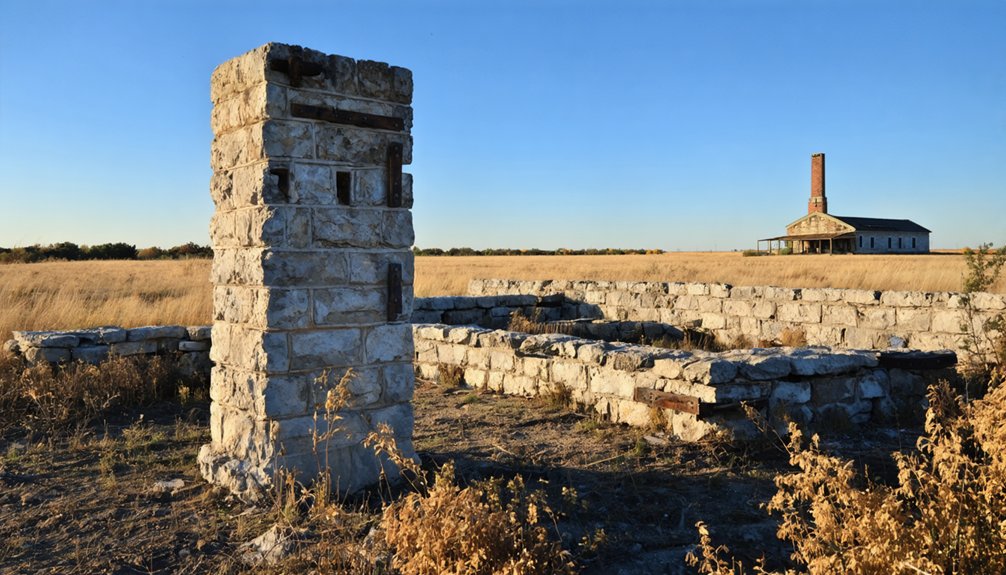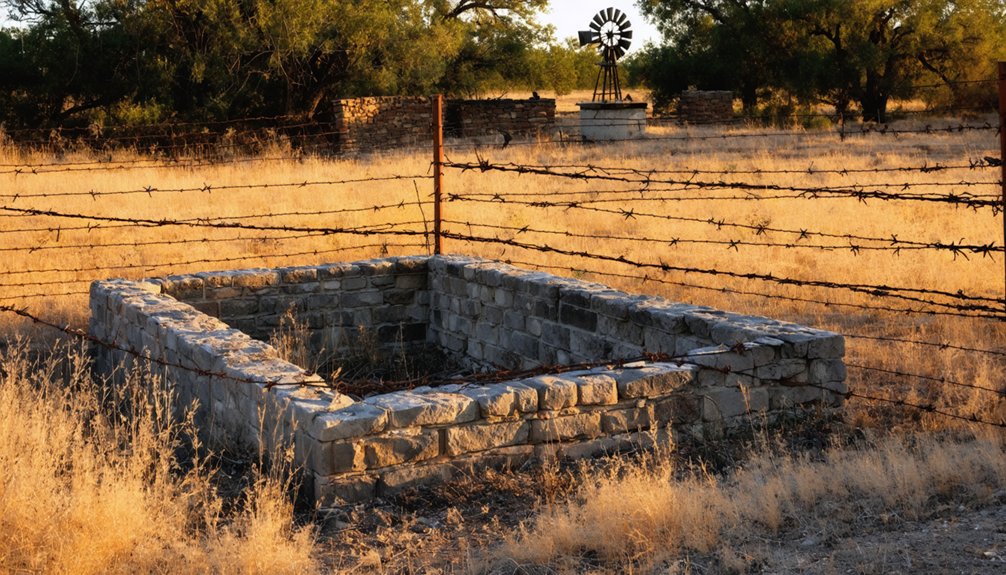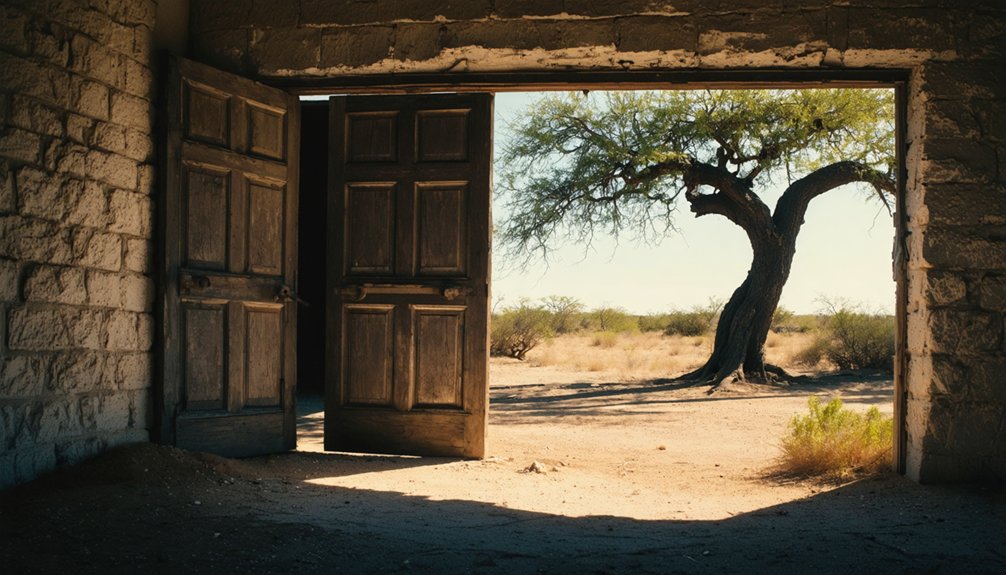You’ll find Larissa’s ghostly remains in Cherokee County, Texas, where a Presbyterian vision for education once thrived. Founded in 1846 by Thomas McKee, the settlement grew to 2,000 residents and hosted the prestigious Larissa College. The town’s decline began when railroads bypassed it, followed by a devastating meningitis outbreak in 1872. Today, only a stone memorial and forest-covered ruins mark this frontier settlement’s ambitious past. The story of Larissa reveals profound insights into Texas’s educational and cultural aspirations.
Key Takeaways
- Larissa was a thriving Texas settlement founded in 1846, reaching 2,000 residents before declining when railroads bypassed the town.
- The community centered around Larissa College, a prestigious Presbyterian institution that operated from 1855 to 1870.
- Economic decline began after a meningitis outbreak in 1872, with the post office’s closure in 1905 marking the town’s abandonment.
- Most of the former settlement is now reclaimed by East Texas forest, with structures remaining on inaccessible private property.
- The Killough Massacre Memorial is the main tourist attraction, commemorating an 1838 tragedy that occurred before the town’s establishment.
The First Settlers: Killough Family’s Vision
Pioneers seeking a fresh start arrived in what would become Larissa, Texas, when the Killough family, accompanied by the Wood and Williams families, made their way from Alabama on Christmas Eve of 1837.
Under Isaac Killough Sr.’s leadership, these determined settlers built homes and cleared land for farming, unaware the Republic of Texas had previously promised this territory to the Cherokee.
The settlers’ dreams of a new home collided with broken promises, as they unknowingly built on land pledged to the Cherokee people.
You’ll find that by August 1838, about 30 settlers had established themselves in Larissa, with the Killough family spearheading efforts to create a thriving agricultural community.
While initial Cherokee relations remained tolerant, tensions grew as more settlers arrived.
The settlers were granted safe passage by Cherokee leaders to retrieve their crops before the violence erupted.
The Killoughs envisioned more than just survival – they were laying groundwork for what would become the permanent settlement of Larissa, demonstrating their commitment through farming, community building, and regional development.
Sadly, their dreams were shattered when eighteen settlers were killed or abducted during the devastating Cherokee attack of October 5, 1838.
The Tragic Massacre of 1838
While the early settlers of Larissa worked their fields on October 5, 1838, a renegade Cherokee band launched a devastating attack that would alter the region’s future forever. The massacre’s impact was swift and brutal – eighteen settlers lost their lives or vanished without a trace.
Isaac Killough Sr. fell in his front yard, while his sons and other men were gunned down in their fields. Women and children were captured, never to be seen again. The survivors fled to Lacy’s Fort for safety. Narcissa Killough’s memoirs were later preserved by her son, providing a firsthand account of the tragedy.
You’ll find that this bloody event marked a turning point in Cherokee relations, fueling President Lamar’s campaign to expel the tribe from Texas territory. The aftermath led to armed conflict, Chief Bowles’s death in battle, and the Cherokee’s forced removal.
Settlement wouldn’t resume until 1846, forever changing the landscape of what you now know as Larissa.
Presbyterian Rebirth and Town Naming
In 1846, Cumberland Presbyterian minister Thomas H. McKee led a group of Tennessee settlers to establish a new religious community in East Texas, bringing Presbyterian values of education and spiritual leadership.
You’ll find McKee’s vision reflected in his choice to name the settlement “Larissa” after the ancient Greek city renowned for learning, deliberately linking his frontier town to classical traditions of scholarship.
Through McKee’s leadership and the Presbyterian Church’s growing influence, the small settlement would transform into a beacon of religious and educational development in 19th century East Texas. The community’s educational focus was evident through the establishment of a one-room schoolhouse in 1848. Like its namesake city which served as the birthplace of Hippocrates, Larissa, Texas aimed to be a center of knowledge and learning.
Religious Vision Shapes Settlement
Driven by their Presbyterian faith and educational aspirations, a group of Cumberland Presbyterians from Tennessee established Larissa in 1846 under Thomas H. McKee‘s leadership.
You’ll find that religious influence deeply shaped the settlement patterns, as these devout settlers aimed to create a beacon of Protestant education and culture in early Texas. The town’s very name, chosen by Reverend T.N. McKee, reflected their vision of a learned Presbyterian community. Sarah Rebecca Erwin became the settlement’s first teacher when classes began in 1848. The settlement achieved formal recognition when it was incorporated in 1850.
- The Brazos Synod provided institutional support and governance for the settlement’s growth.
- Early families like the Newtons, Ewings, and Yoakums demonstrated unwavering Presbyterian loyalty.
- Curriculum at Larissa College combined classical studies with religious values.
- The community’s structure followed Presbyterian social norms, including gender-separated education.
McKee’s Presbyterian Leadership Role
Thomas H. McKee, a Presbyterian minister from Tennessee, transformed the Texas frontier when he led settlers to establish McKee Colony in 1846.
You’ll find McKee’s influence deeply embedded in the settlement’s foundation, as he deliberately chose this location to create a community aligned with Presbyterian values, away from what he viewed as morally compromised towns.
His son, Reverend T.N. McKee, furthered this vision in 1847 by laying out the formal townsite and renaming it Larissa, after the ancient Greek center of learning.
This strategic naming reflected the Presbyterian commitment to education and cultural development. Like its Greek namesake, which was a major agricultural center in ancient times, the Texas town emphasized farming as a cornerstone of its economy.
Together, the McKees established a one-room schoolhouse in 1848, which evolved into Larissa College by 1856, cementing their legacy of combining religious devotion with intellectual pursuit.
Ancient Greek Name Origins
While the McKee family established their Presbyterian colony in 1846, it wasn’t until 1847 that Reverend T.N. McKee chose to name the settlement Larissa, drawing inspiration from an ancient Greek city renowned for its learning and cultural achievements.
The name selection reflected deeper cultural aspirations for this Texas frontier town, distinguishing it from neighboring settlements like Talladega that were known for their saloons and loose morals.
- The ancient influences of classical education shaped the Presbyterian founders’ vision for an orderly, educated society.
- Naming after Larissa in Thessaly symbolized their commitment to academic excellence.
- The choice represented a deliberate break from the wild frontier stereotype.
- You can see how the name embodied their dream of creating a civilized, principled community focused on education and religious values.
The town’s promising future was tragically cut short when a devastating meningitis outbreak in 1872 caused many residents to flee the area.
Growth and Golden Years: 1847-1872

After establishing its Presbyterian roots, Larissa quickly transformed into a thriving educational and commercial center, with a population reaching 2,000 residents by the mid-1850s.
You’d find the town’s three-story college building and dormitories standing prominently among various stores and residences, reflecting the community’s commitment to both learning and commerce.
The town’s golden age showcased its successful blend of Presbyterian values, educational excellence, and economic growth, all while maintaining its alcohol-free environment that distinguished it from neighboring settlements.
Presbyterian Education Center
In 1847, Presbyterian education took root in Larissa when T.N. McKee established a one-room schoolhouse that would evolve into one of Texas’ most influential educational centers.
You’ll find that Larissa Academy‘s transformation into Larissa College under the Cumberland Presbyterian Church in 1855 marked a turning point in the region’s educational impact and cultural significance.
- The college’s three-story main building and observatory housed scientific equipment superior to Yale’s, showcasing the institution’s commitment to advanced learning.
- You’d discover a rigorous curriculum featuring Latin, French, Spanish, chemistry, physics, and mathematics.
- The co-educational structure maintained gender separation while providing equal learning opportunities.
- Local families like the McKees, Newtons, and Ewings formed deep connections with both church and educational endeavors.
Commerce and Population Boom
The ambitious vision of T.H. McKee and early settlers transformed Larissa into a bustling frontier town that’d reach over 2,000 residents by the mid-1850s.
You’d have found a thriving community where commercial activities flourished, with general stores and service providers meeting the needs of the growing agrarian population.
The town’s remarkable population dynamics reflected its rising prominence in northeastern Cherokee County.
As you explored the streets during this golden age, you’d have witnessed a diverse economy supporting farmers, merchants, and educators.
Multiple churches dotted the landscape, while a magnificent three-story college building stood as evidence to the town’s cultural aspirations.
This period marked Larissa’s peak, as settlers from surrounding areas flocked to the promising settlement seeking opportunities in commerce, education, and agriculture.
Community Building and Progress
While establishing formal foundations in 1847, Larissa’s early settlers quickly developed a richly layered community centered on education, faith, and social progress.
Under the McKee family’s leadership, you’d find the town’s educational aspirations taking shape through a three-story college and dormitories by the 1850s. The Presbyterian influence fostered strong community cohesion, with churches and social gatherings bringing residents together in purposeful ways.
- The town purposefully distanced itself from neighboring Talladega’s saloons, reflecting its commitment to moral values.
- Educational facilities attracted students from across the region, establishing Larissa as a center of learning.
- Religious institutions provided both spiritual guidance and social structure.
- The post office’s establishment in 1847 marked the town’s growth as a proper settlement with essential infrastructure.
Daily Life in a Frontier Settlement

Life in Larissa’s early settlement demanded extraordinary resilience from pioneering families like the Killoughs, who arrived in 1837 to establish homesteads amid challenging frontier conditions.
You’d find settlers living in basic log huts, clearing dense forest for farmland while constantly watching for threats from local Native American groups.
Your daily routine would’ve centered around survival tasks – hunting game for food, tending to corn crops through communal farming efforts, and helping neighbors during harvests.
Basic medical care relied on home remedies, while safety often meant temporarily abandoning your home during periods of conflict.
Despite these hardships, you’d see the community’s determination through their establishment of essential buildings and eventual founding of Larissa College, showing settler resilience in transforming wilderness into a structured settlement.
Economic Forces and Population Shifts
During Larissa’s peak in the 1850s, you’d find a bustling frontier economy anchored by John Durst’s sawmill operations, multiple general stores, and the prestigious Larissa College.
However, the town’s economic decline accelerated when railroads bypassed the settlement. The transportation impact proved devastating – the Kansas and Gulf Short Line Railroad missed Larissa by three miles, while the Great Northern Railway ran eight miles south, drawing commerce and residents to better-connected towns like Mount Selman.
- A meningitis epidemic in 1872 decimated the population, weakening an already struggling workforce.
- The closure of Larissa College in 1870 removed a crucial economic engine.
- Rail-connected competitors like Jacksonville and New Birmingham drew away remaining business.
- By 1905, the post office’s closure signaled the end of Larissa’s commercial relevance.
Remnants and Landmarks Today

Today’s visitors to Larissa encounter a stark contrast to its vibrant past, with dense East Texas forest reclaiming most of the former settlement.
You’ll find the Killough Massacre Memorial as the site’s most prominent historical preservation effort, featuring interpretive markers that detail the 1838 tragedy. While a handful of original residential structures and a lodge hall remain standing, they’re scattered and largely inaccessible on private property.
The ghost town tourism experience centers around the memorial site, which you can visit daily between 8 a.m. and 8 p.m.
You’ll need to navigate small local roads to reach this secluded location, situated about 20 miles northwest of Rusk.
Besides weathered historical markers and the memorial, nature has mostly reclaimed this once-thriving community’s footprint.
The Legacy of a Lost Texas Town
While Larissa’s physical structures have largely vanished into the East Texas wilderness, the town’s fascinating legacy endures as a tribute to early Texas settlement patterns and cultural aspirations.
Today, you’ll find Larissa’s historical significance woven into the broader narrative of Texas frontier life, from its tragic beginnings with the Killough Massacre to its emergence as a center of learning and religious devotion.
- The town exemplifies the cultural heritage of early Presbyterian settlers who sought to establish communities centered on education and moral values.
- Larissa College stands as one of Texas’ pioneering higher education institutions, even though its buildings no longer exist.
- The town’s rise and fall mirrors countless other frontier settlements that succumbed to changing economic and transportation patterns.
- Its name choice reflects the settlers’ classical aspirations and desire to create a sophisticated cultural center in the Texas frontier.
Frequently Asked Questions
What Was the Average Land Price in Larissa During Its Peak Years?
You’ll find that during peak economic trends (1850s-1870s), land values ranged from $5-$20 per acre within town limits, with prime locations near the college commanding higher prices.
Were There Any Notable Crimes or Lawlessness Incidents Besides the Massacre?
Like a calm pond after a storm, you won’t find records of other major crimes. Historical documents show no significant law enforcement issues or elevated crime rates beyond the 1838 massacre.
What Types of Crops Were Primarily Grown by Larissa’s Farmers?
You’ll find corn was Larissa’s primary crop, with settlers clearing forests specifically for cornfields. While cotton production and crop rotation likely occurred, historical records don’t confirm these as major agricultural practices.
Did Any Famous Historical Figures Ever Visit or Pass Through Larissa?
Despite being home to 2,000 people at its peak, there’s no credible evidence that any famous historical figures visited Larissa. The town’s historical significance centered on local pioneers and educational development.
What Happened to the Descendants of the Original Presbyterian Settlers?
You’ll find descendant stories scattered across Texas, as families moved west or stayed nearby in Cherokee County, maintaining their Presbyterian cultural heritage through church involvement and local institutions.
References
- https://mix931fm.com/cherokee-county-ghost-towns/
- https://www.tshaonline.org/handbook/entries/larissa-tx
- https://www.loquis.com/en/loquis/6570531/Larissa+Texas
- https://allacrosstexas.com/texas-ghost-town.php?city=Larissa
- https://wildstorm.wordpress.com/2017/03/15/larissa-texas/
- https://1dustytrack.blogspot.com/2017/08/old-larissa-and-killough-massacre.html
- https://www.texasescapes.com/TexasGhostTowns/Larissa-Texas.htm
- https://en.wikipedia.org/wiki/Killough_massacre
- http://killough.org/archives/ubs.htm
- http://killough.org/archives/tlim.htm



